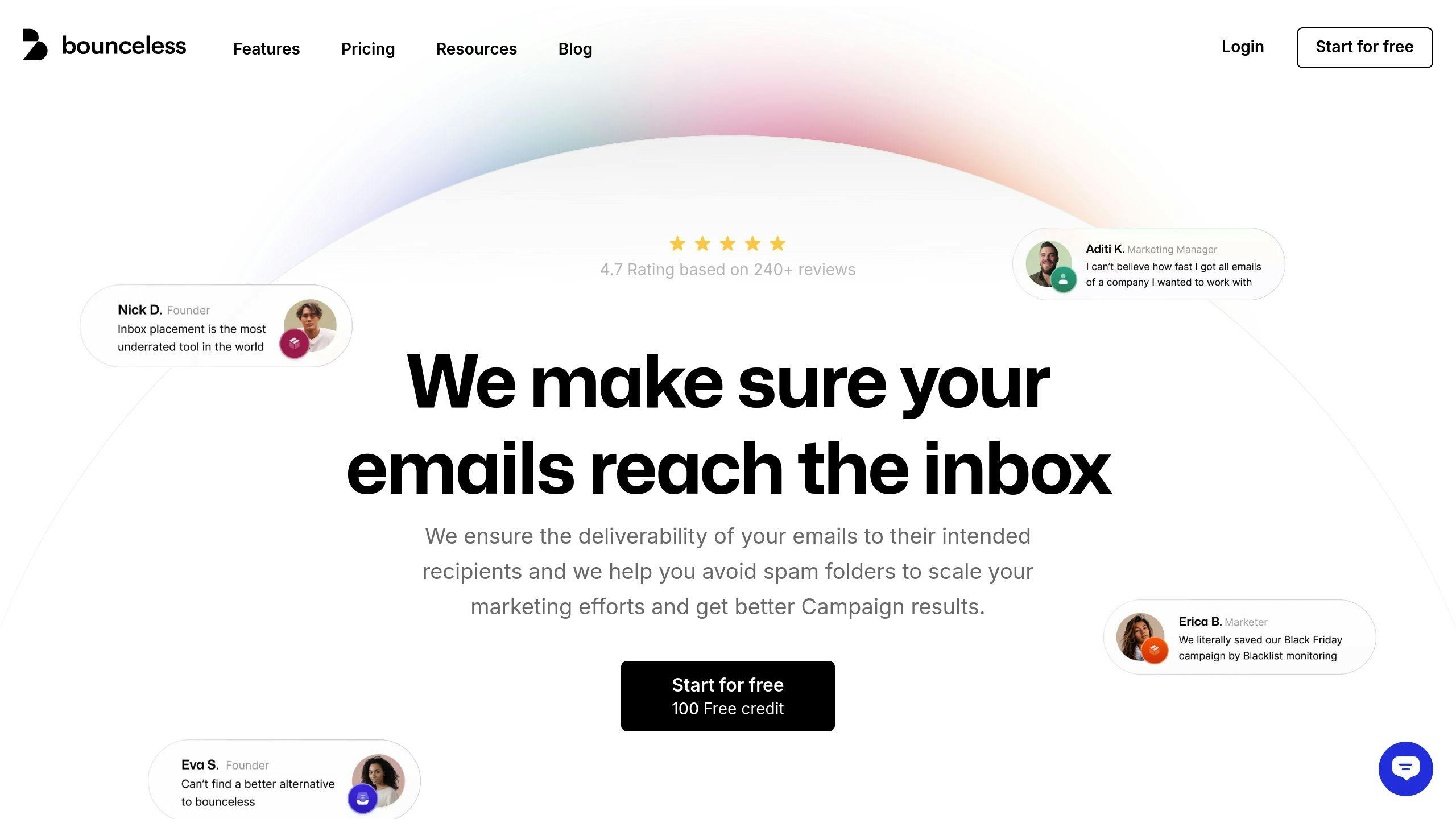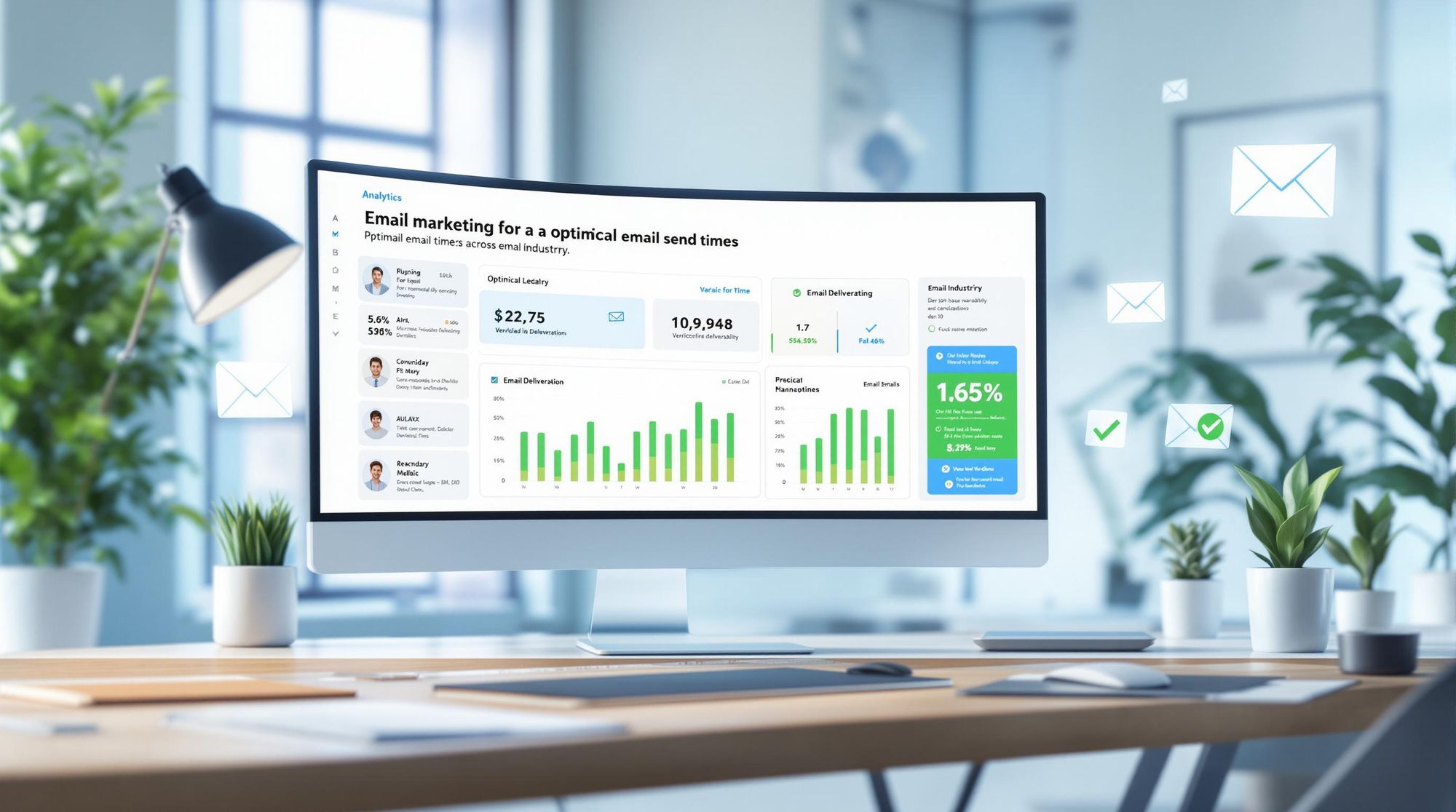Here’s what you need to know:
- B2B emails: Best sent mid-morning on Mondays or Tuesdays during work hours.
- B2C emails: Perform better in the evenings, on weekends, or Thursdays at 10 a.m.
- Industry-specific trends: For example, Health & Fitness emails see peak engagement from 9-11 a.m., while E-commerce performs better from 5-6 p.m.
- Clean email lists matter: Tools like Bounceless help ensure your emails reach valid inboxes, boosting deliverability and engagement.
How to Find the Perfect Day and Time to Send Your Emails
1. How Bounceless Can Help

Timing your email campaigns perfectly is crucial, but it won't matter much if your emails don't reach the right inboxes. That's where Bounceless steps in - helping ensure your email lists are clean and verified so your messages hit their mark at the best possible time.
Email List Quality and Deliverability
Bounceless works by scrubbing your email lists of invalid and disposable addresses, while also flagging problematic domains and delivery issues. This process boosts your email deliverability and engagement rates, all while protecting your sender reputation.
"By removing invalid addresses, Bounceless can help reduce bounce rates by up to 10x, which keeps sender reputation up to par" [4]
Spam Trap Detection
Spam traps can wreak havoc on your email campaigns. Bounceless identifies and removes these harmful addresses, helping you avoid spam filters and ensuring your emails land in the inbox during critical engagement periods.
Integration Capabilities
Bounceless connects effortlessly with popular email platforms, allowing features like automated list cleaning, real-time monitoring, and performance tracking. This makes it easier to maintain clean lists and deliver your campaigns to engaged recipients, right when they're most likely to respond.
Advantages and Drawbacks of Using Email Tools
Email verification tools are essential for fine-tuning email campaigns, especially when timing plays a key role in engagement. While these tools offer clear benefits, they also come with some challenges marketers should be aware of.
Key Advantages
Better Deliverability
Email verification tools help ensure your emails actually land in inboxes by keeping your lists clean. For example, ZoomInfo reports that its validation services can cut bounce rates by as much as 99.9% [2]. This means your messages are more likely to reach your audience.
Lower Costs
By maintaining a clean email list, you avoid wasted resources on invalid addresses, making your campaigns more cost-efficient and timely.
Improved Data Quality
Modern tools come packed with features that help maintain list hygiene, which directly impacts your campaign timing:
| Feature | Benefit | Impact on Timing |
|---|---|---|
| Real-time Verification | Blocks invalid emails immediately | Keeps campaigns ready to launch |
| API Integration | Automates the verification process | Ensures consistent list quality |
Notable Limitations
Reliance on Technology
Even with top-notch verification tools, other factors like your content's relevance and how well your timing aligns with audience behavior are crucial. Experts note that even with a 98% delivery success rate, open rates often hover between 20-40% [4].
Costs for Premium Services
High-quality verification services can be pricey, especially for businesses managing large email lists. It's important to weigh these costs against the potential return on investment.
Integration Challenges
Although many tools integrate with email platforms, technical hiccups can sometimes delay critical campaigns.
Implementation Strategies
To get the most out of email verification tools, schedule regular cleanups and combine them with well-thought-out content and timing strategies. Keep an eye on metrics like deliverability, bounce rates, and engagement to see how these tools improve your campaign performance.
Conclusion
Mastering email timing requires blending data-driven strategies with dependable tools. Timing can vary by industry - B2B emails tend to perform best mid-morning, while B2C campaigns often see higher engagement during evenings and weekends [1][3].
Email marketing continues to deliver strong returns, with an average ROI of $36 for every dollar spent. Combining this with strategic timing and proper list management can amplify results. Tools like Bounceless help ensure emails are sent to valid recipients, increasing the chance of engagement during peak times.
Here’s a quick look at how timing influences performance across industries:
| Industry Sector | Peak Engagement Time | Average Open Rate |
|---|---|---|
| Health & Fitness | 9-11 AM | 48.9% |
| Non-profit | 1-2 PM | 53.21% |
| E-commerce | 5-6 PM | 31.08% |
| Travel | 8-10 AM | 22.57% |
"Emailing only valid and active addresses allows you to connect with people who care about your brand, and that's what every email marketer wants." - Liviu Tanase, CEO of ZeroBounce [4]
To make the most of these insights, businesses should prioritize:
- Tracking engagement metrics to pinpoint the best send times for their audience.
- Using email verification tools to maintain clean lists and ensure high deliverability.
- Segmenting audiences by behavior and demographics for more precise targeting.
- Testing different send times regularly to adapt to shifting audience preferences.
Automated campaigns sent at the right time consistently outperform manual sends in terms of open and click-through rates [2]. As we approach 2025, success in email marketing will depend on timing strategies tailored to industry trends, supported by reliable tools and a focus on clean, optimized email lists.
FAQs
What is the best time to send emails by industry?
The best timing for email campaigns depends on the industry. Here's a quick guide:
| Business Type | Best Day | Best Time |
|---|---|---|
| Marketing Services | Wednesday | 4 PM |
| Offline Retail/Hospitality | Thursday | 8-10 AM |
| Professional Services (B2B) | Monday/Tuesday | 8-10 AM |
| NGOs (Nonprofits) | Tuesday/Thursday | 3 PM |
| E-commerce | Tuesday/Thursday | 10 AM |
| SaaS | Tuesday/Thursday | 2-3 PM |
Using email verification tools like Bounceless can help ensure your messages land in valid inboxes at these prime times.
What time are people most likely to open an email?
Engagement depends on several factors, such as:
- Industry: Different sectors have different peak times.
- Audience behavior: When your audience is most active.
- Location: Time zones play a big role.
- Content type: The kind of message you're sending.
Generally, emails see higher engagement during morning, afternoon, and evening peaks. Activity tends to drop off between 6 PM and 5 AM [1]. To keep your audience interested, aim for 2-5 campaigns per month.

